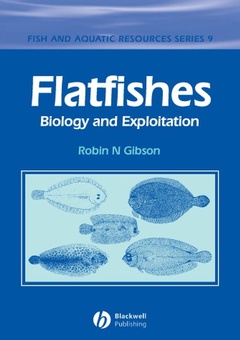Flatfishes : biology & exploitation
Auteur : GIBSON Robin

Preface.
Acknowledgements.
List of Contributors..
1. Introduction (Robin N. Gibson).
1.1 The fascination of flatfishes.
1.2 A brief history of flatfish research and its contribution to fish biology and fisheries science.
1.3 Scope and contents of the book.
1.4 Nomenclature.
Acknowledgements.
References..
2. Systematic diversity of the Pleuronectiformes (Thomas A. Munroe).
2.1 Introduction.
2.2 Systematic profile of the Pleuronectiformes.
2.3 Intrarelationships of the Pleuronectiformes.
2.4 Brief synopses of the suborders and families.
2.5 Diversity of the Pleuronectiformes.
2.6 Patterns of species diversity among pleuronectiform families.
2.7 Conclusions.
Acknowledgements.
References..
3. Distributions and biogeography (Thomas A. Munroe).
3.1 Introduction.
3.2 Geographic distribution of pleuronectiform lineages.
3.3 Global patterns of species richness for the Pleuronectiformes.
3.4 Species richness in specific environments.
3.5 Historical biogeography..
4. Ecology of reproduction (A.D. Rijnsdorp and P.R. Witthames).
4.1 Introduction.
4.2 Spawning.
4.3 Gonad development.
4.4 Age and size at first maturation.
4.5 Energetics.
4.6 Contaminants and reproduction..
5. The planktonic stages of flatfishes: physical and biological interactions in transport processes (Kevin. M. Bailey, Hideaki Nakata and Henk W. van der Veer).
5.1 Introduction: the problem.
5.2 Flatfish eggs and larvae in the plankton: variations in form and function, time and space.
5.3 Physical mechanisms of transport and retention.
5.4 Adaptations to transport conditions: geographical and species comparisons.
5.5 Transport and population biology..
6. Recruitment (Henk W. van der Veer and William C. Leggett).
6.1 Introduction.
6.2 Range of distribution.
6.3 Average recruitment levels.
6.4 Recruitment variability..
7. Age and growth (Richard D.M. Nash and Audrey J. Geffen).
7.1 Introduction.
7.2 Age estimation.
7.3 Growth of larvae.
7.4 Growth during metamorphosis.
7.5 Growth on nursery grounds.
7.6 Growth of adults.
7.7 Longevity..
8. Ecology of the juvenile and adult stages of flatfishes: distribution and dynamics of habitat associations (Kenneth.W. Able, Melisssa Neuman and Hakan Wennhage).
8.1 Introduction.
8.2 Definitions.
8.3 Distribution and ontogeny.
8.4 Future emphasis..
9. The trophic ecology of flatfishes (Jason S. Link, Michael J. Fogarty and Richard W. Langton).
9.1 Introduction.
9.2 Major flatfish feeding groups.
9.3 Flatfish predators.
9.4 Flatfish competitors.
9.5 Flatfish trophic dynamics: a case study of Georges Bank.
9.6 Summary and conclusions..
10. Behaviour of flatfishes (Robin N. Gibson).
10.1 Introduction.
10.2 Locomotion and related behaviour.
10.3 Colour change.
10.4 Reproduction.
10.5 Feeding.
10.6 Predation and reactions to predators.
10.7 Movements, migrations and rhythms.
10.8 Behaviour in relation to fishing, aquaculture and stock enhancement..
11. Atlantic flatfish fisheries (Richard Millner, StephenJ. Walsh and Juan M. Diaz de Astarloa).
11.1 Introduction.
11.2 Main species and nature of the fisheries.
11.3...
Date de parution : 04-2005
Ouvrage de 448 p.
17x24 cm



